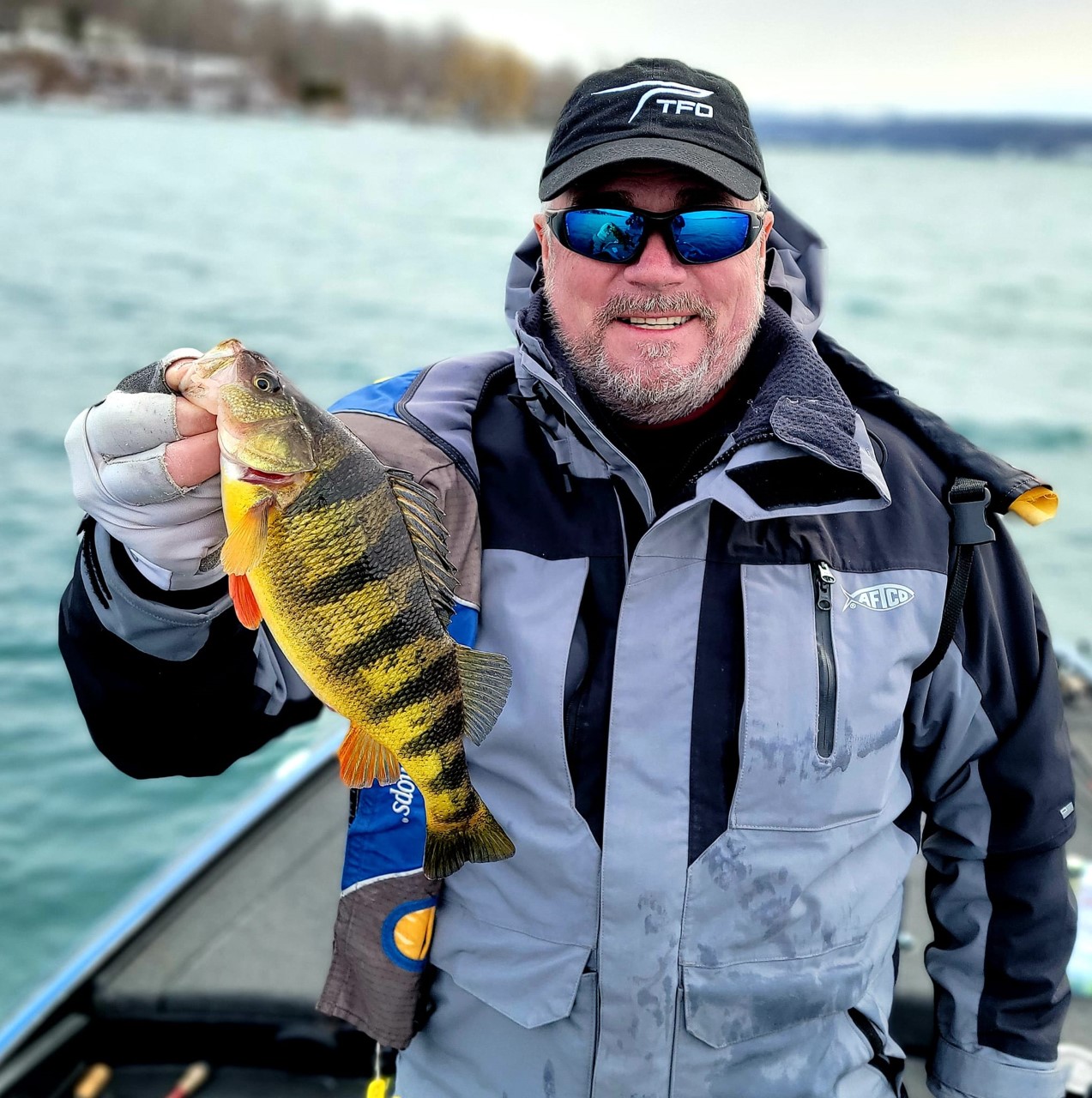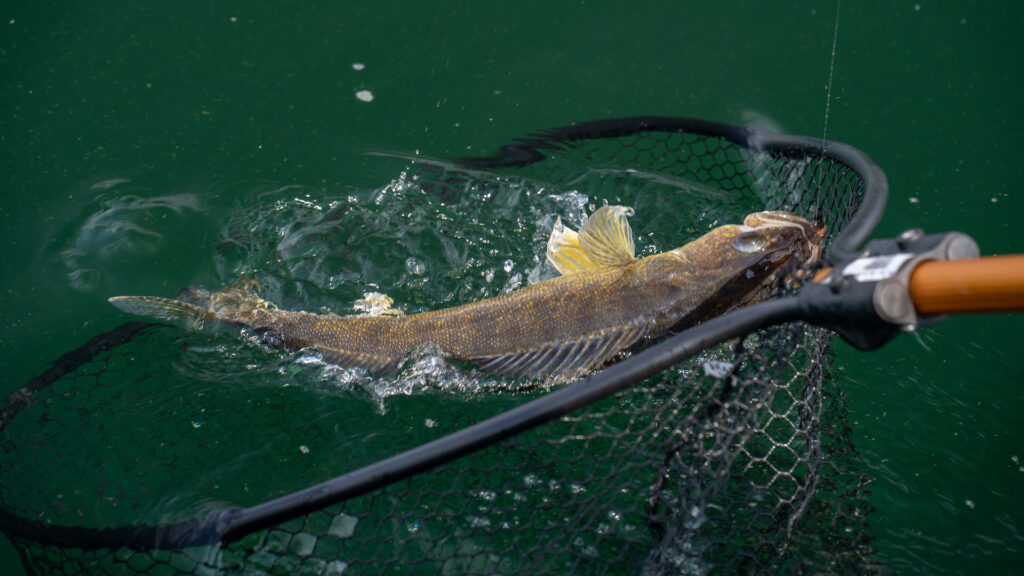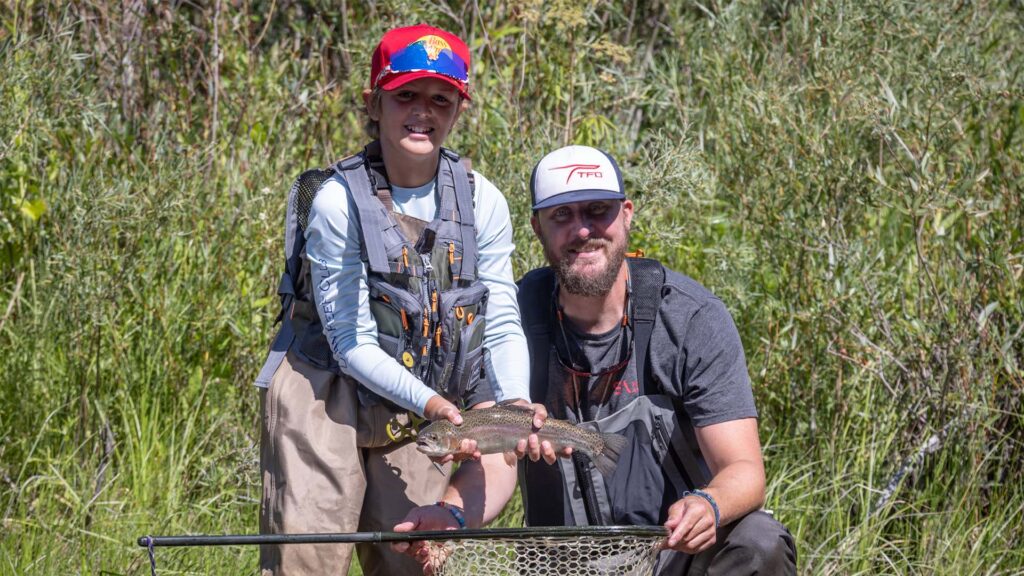Perch will usually spawn in early April thru mid-May, depending on water temperatures, and overall weather conditions. Look for water temperatures in the 45-58 degree range and if the water remains cooler, sometimes they’ll spawn as late as early June. I find my early season perch in deeper water around 28- to 35 -foot with temperatures running 34- to 36-degrees and as the water temperatures rise into the low 40-degrees I start looking in shallower water, 4- to 9-foot, around hard bottom areas with scattered vertical vegetation.
The females will lay their eggs in sticky clutches on vegetation or sometimes cobble rock and the males will swim by to fertilize the eggs, once fertilized the eggs are on their own. Perch don’t guard their fry like other fish do and oftentimes they’ll return to the same general area to eat their own young. It’s their ravenous appetite that makes them very susceptible to small grubs and finesse swimbaits.
To enjoy these fish, it’s best to select gear that won’t overpower the fish yet allows for the best presentation when casting light lures to them. The rod and reel I use is TFO’s Trout-Panfish spinning rod model TPS 701-1, Ultralight (UL) rated for 2- to 6-pound test. I pair this rod with a size 1000 spinning reel spooled with 4- to 5-pound line. This combination provides accuracy and good distance when casting finesse baits, worms, or minnows for these perch. I prefer to use lures when targeting perch and here are a few things that work well for me.

TFO’s Trout-Panfish spinning rod model TPS 701-1 is an excellent tool to fish for perch.
First, is choosing lures with a light wire hook and the right size hook. I’ve enjoyed good success casting small minnow imitators like Lucky Craft’s Pointer 78, Rapala Ultra-Light Rippin Rap in 3/16-ounce size for hard baits and 2-inch curly tail grubs by Big Bite Baits or 2.8- to 3-inch swimbaits by Keitech for soft bait selections.
For the hard baits size six or eight hooks are my choice and I rig the grubs and swimbaits baits on one-eighth ounce or one quarter ounce ballhead jigs with a size one hook. I’ll fish these baits on either 4-pound test monofilament, or I’ll use 5-pound test Cortland Masterbraid. Both lines work well, but I do seem to get a bit more distance when casting the Masterbraid. The presentations for the hard baits differ slightly from the soft bait, but the common denominator is maintaining sharp hooks on any lure you’re casting, and to keep those hooks sticky sharp, I always carry a small file with me on every trip.

Rippin Rap + Pointer 78

Keitech Swimbaits
When casting the hard baits, I employ a standard jerk-jerk-pause retrieve for the Pointer 78 and the lipless rattle baits performs very well on either a steady retrieve or a yo-yo retrieve. To perform the yo-yo retrieve, cast the lure out, let it fall to the bottom on a semi-tight line, then work it back to you with short deliberate lifts of the rod from the 9- to 12- O’clock position following the lure down on a semi-tight line as it falls back through the water column. Employing the yo-yo retrieve is a bit of trial and error as you cast out and count it down until the lure makes bottom contact, but once you get the right depth dialed in, it’s a highly effective method and a lot of fun.
I’ve found the grubs and swimbait perform best using a steady retrieve. I cast out and let the bait fall until I believe it’s about 12- to 18-inches over the vegetation or the bottom and then I begin a slow steady retrieve. Once you start hooking up, remember what you did to catch those first couple of fish and try to repeat it on every cast. I’ve had days where the difference in hooking up or drawing a blank on every cast was just a matter of counting the lure down from four to say six foot. I realize that sounds weird given the aggressive nature of perch but attention to details are particularly important.
As you retrieve the grub or swimbait remember to wait until you feel the weight of the fish on the end of the line. Oftentimes you’ll feel the initial peck as the perch strikes the soft plastic and if you get excited and set the hook as soon as you feel the peck you can take the lure out of the fish’s mouth before the hook can penetrate. Again, I can’t emphasize this enough, when perch fishing with most horizontal presentations you need to wait until you feel the fish on the line before you set the hook.
Another great presentation for perch is using these same finesse swimbaits on a dropshot rig. When I dropshot for perch I usually start with single rig and depending on the bite I may employ a tandem rig.
When tying a single dropshot rig I determine how high the sparse vegetation is up off the bottom and I want to tie my hook about 6- to 8-inches above that. This ensures when the weight reaches the bottom that the bait suspends slightly above the vegetation where it’s easily seen by the perch. If the bite is active, then I’ll employ a tandem dropshot rig and the second hook is tied in approximately 10- to 12-inches above the first hook. The single or tandem dropshot rig also requires a “wait until you feel it mentality” because perch are notorious for tapping a bait several times before they finally commit to it.
This “wait until you feel it” can sometimes be frustrating as you focus to keep your excitement in check; however, it’s also very handy when sharing these finesse fishing techniques with youth or first-time angling adults. Both groups are not used to fishing, translating to slower reaction times regarding hooksets, which in this instance is perfect for the “wait until you feel it” technique.
I believe casting finesse baits to perch, especially soft plastics (grubs and swimbaits) is a great way to introduce youngsters and first-time anglers to lure fishing. Perch are usually willing participants, they provide great table fare, and they’re plentiful across most waters.
So, get geared up right, and enjoy these scrappy panfish by yourself or better yet take a youngster with you.

TFO Ambassador and blog author Burnie Haney
About the Author
Burnie Haney is a Licensed U.S. Coast Guard Captain owner & operator of New York Fishing Adventures based out of Henderson Harbor NY on Lake Ontario. He’s a member of the Jefferson County Sports Fishery Advisory Board to the New York Department of Environmental Conservation (NY DEC) Region 6 Fisheries Chief and he serves as the Jefferson County Sportsman’s Representative to the NY DEC Region 6 Fish and Wildlife Management Board. Haney holds two International Game Fish Association (IGFA) New York State line class records (smallmouth bass and walleye) and the IGFA All-Tackle Length World Record for Chain Pickerel. You can find out more about Burnie here.






